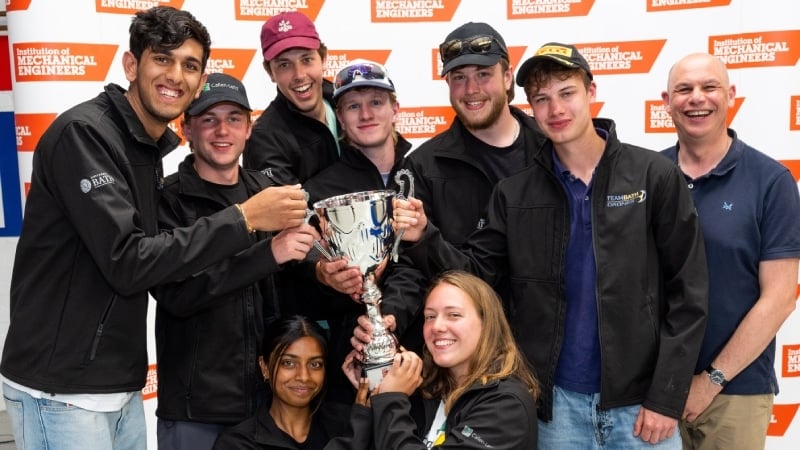The 2025 UAS Challenge—also known as the “Drone Olympics”—once again transformed the UK into a hub of international aeronautical innovation. Top student engineers from across the globe gathered, culminating in an exciting finale at BMFA Buckminster, Lincolnshire. This event has become pivotal in advancing drone technology, promoting new aerospace talent, and fostering global collaboration. Let’s delve into this year’s competition, its significance, and its implications for the future of autonomous aviation.
2025 UAS Challenge: A Global Exhibition in the UK
This year, 32 elite university teams from countries like China, Italy, the Netherlands, Estonia, Turkey, and Ireland descended upon the UK’s BMFA Buckminster flying site—dubbed the “Wimbledon of drones.” Their mission was to design, construct, and autonomously fly drones through a series of complex tasks, encompassing aspects like waypoint precision and humanitarian aid delivery.
Speed wasn’t the sole criteria for victory. Judges examined each entry’s engineering innovation, environmental sustainability, safety, operational efficiency, and notably, the ability to conduct autonomous flight missions simulating real-world situations.
Introducing the 2025 Champions: Team Bath Drones
Following a near miss last year, University of Bath’s Team Bath Drones secured the Grand Champion title. Their triumph was no coincidence, as over 100 Bath students from various disciplines including aerospace, mechanical, electrical engineering, management, and computer science contributed to developing a drone that excelled in multiple areas:
- Autonomous navigation through challenging courses
- Humanitarian aid delivery, emulating vital real-world drone applications
- Focus on efficiency, maneuverability, and environmental sustainability
Team lead, Ashviny Ramanathan, having just completed a Master’s in Aerospace Engineering, expressed: “Winning such a prestigious global competition amidst tough competitors is truly extraordinary. Our team put in immense effort to refine our drone for enhanced flight performance and construction, making our overall victory an incredible way to conclude our season. We aim to replicate this success next year.”
Runners-up included the Beihang Aeromodelling Team from China, who were last year’s champions, closely contesting until the final flight. Italy’s Fly-Mi, representing Politecnico di Milano, debuted and clinched third place, signaling the increasing competitiveness in international drone design.
Highlighting Innovation: Notable Designs & Technologies
This year, the “open” ruleset prompted bold creativity and diversity in drone designs:
- Catapult Launched Drones: Teams like Beihang from China and Heriot-Watt University from the UK introduced custom launch systems, showcasing aerospace’s shift from traditional runway designs to more adaptable operations.
- VTOL Tailsitter: Estonia’s Blue Sparrow team astonished with a “tailsitter” model—a drone that ascends and lands vertically but transitions to airplane-style flight mid-air. This innovative design scored high on creativity and executed a successful autonomous payload drop, a first for the competition.
- Simulation & Safety: Teams utilized advanced AI and simulation models, remarkably advancing safety, flight efficiency, and the reliability of autonomous missions.
Special Awards: Celebrating Excellence
| Award Name | Winner |
|---|---|
| Grand Champions | Team Bath Drones (University of Bath) |
| Runners Up | Beihang Aeromodelling (Beihang Univ.) |
| Third Place | Fly-Mi (Politecnico di Milano) |
| Innovation Award | Blue Sparrow (Estonian Av. Academy) |
| Design Award | DroneTeam Twente (Univ. of Twente) |
| Simulation Award | Gryphon Arrows (Univ. of Leeds) |
| Scrutineering Award | Team Bath Drones |
| Safety Award | Fly-Mi |
| Environmental Award | Team Bath Drones |
| Airworthiness Award | UCD UAV Team (Univ. College Dublin) |
| Operational Supportability | Blue Sparrow (Estonian Av. Academy) |
| Business Proposition Award | UCD UAV Team |
| Most Promise Award | Team Aero-Watt (Heriot-Watt Univ.) |
| Advancement Award | DOPE Aerospace (Univ. of Genova) |
| Media & Engagement Award | DroneTeam Twente |
These accolades recognize not only technical mastery but also innovation, practical business understanding, and adept public engagement—capabilities vital for future leaders in the evolving drone sector.
The Importance of This Competition
1. STEM Talent Development
For students, the UAS Challenge acts as a paramount launchpad for aerospace careers. Participants gain invaluable hands-on experience in:
- Project management: Transforming concepts into tangible aircraft within tight deadlines
- Team collaboration: Merging diverse skills under pressure
- Industry networking: Connecting with sponsors such as BAE Systems, Leonardo, and Ansys, gaining invaluable career visibility pre-graduation.
2. Propelling Drone Innovation
The flexible design requirements promote swift “evolution” in aerial robotics, similar to open-source software environments. The insights gained drive trends in:
- Civilian sectors: Including medical supply deliveries, search and rescue operations, and environmental monitoring
- Commercial operations: Logistics, industrial inspections, and agricultural automation
3. Encouraging International Collaboration
The contest transcends borders, creating an atmosphere of cooperation where budding engineers from China to the Netherlands exchange ideas and techniques. The culture focuses less on “winning” and more on the shared progress realized in the drone industry.
4. Showcasing the UK as a Drone Innovation Leader
For the eleventh year, the UK’s BMFA Buckminster has hosted the event, with the nation further cementing its status as a global leader in drone R&D, regulation, and industry engagement.
Fun Insights & Cultural Highlights
The “catapult vs. tailsitter” debate sparked such fervor among participants that an Italian team member humorously remarked, “It’s not just Top Gun, it’s Top Catapult!” Judges likened the diverse drone shapes to “Wacky Races”—highlighting AI yet minimizing the cartoon antics. Over 80 volunteers dedicate themselves to the event—a mix of enthusiasts, experienced engineers, and past competitors giving back to the community.
Expert Advice: Charting a Course from Competition to Commercial Drone Success
1. Embrace Autonomy: Even hobbyists can explore open-source autopilots and AI borrowed from academic ventures, enhancing safety and capability.
2. Value Team Diversity: Triumphant teams thrive when aerospace, computer science, and business students collaborate.
3. Design with Real-World Challenges in Mind: Humanitarian and logistics roles reflect the drone sector’s significant growth areas.
4. lean Toward Sustainability: Eco-friendly designs are gaining importance. Lightweight structures, reduced noise, and greener materials are becoming crucial for potential buyers and regulators.
Real-World Success Stories: UAS Alumni in the Industry
Many UAS Challenge alumni have transitioned their experiences into roles with leading aerospace firms like Airbus, BAE, and DJI, or have founded startups in drone services and aerial technology.
“The contest instilled great confidence, leading me to the aerospace sector. My first job was secured through my UAS portfolio—my interviewers were event volunteers!”
—Former participant, now a systems engineer at BAE Systems
The Business Ecosystem: Sponsors & Industry Partners
The competition thrives on the backing from aerospace titans like BAE Systems and Leonardo, simulation experts like Ansys, alongside dynamic drone-tech firms and startups. Their support translates into substantial prize pools, valuable networking sessions, and even potential job offers.
Looking Forward: 2026 and Beyond
Interest in the UAS Challenge is skyrocketing, with anticipation for an increased participant roster in 2026 and new rule adaptations encouraging greater AI use, enhanced autonomy, and carbon-neutral designs. With AI-empowered racing drones making headlines elsewhere, future contests may witness even more “machine-vs-human” spectacles.
Conclusion
The 2025 UAS Challenge encompasses more than just a contest; it is a breeding ground for innovation, a gateway into STEM fields, and a practical playground influencing the future commercial UAV landscape. Whether you’re a student exploring your first drone project, a business seeking aerospace insights, or simply a drone enthusiast, the competition offers a wealth of practical lessons and inspiration.
Ready to embark on this journey? Mark your calendars for October 2025, when the next wave of exceptional drone designs takes flight. The future of aviation is not just approaching—it’s flying autonomously, and your name could be a part of it.













